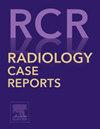从脑卒中到线粒体疾病:MELAS 1例报告
Q4 Medicine
引用次数: 0
摘要
线粒体脑肌病、乳酸酸中毒和卒中样发作(MELAS)是一种罕见的线粒体疾病,通常表现为反复出现的神经功能障碍,类似缺血性卒中。然而,MELAS病变的特点是侵犯血管区域,这种模式在成年患者中可能被低估,特别是当血管危险因素混淆临床怀疑时。我们报告一例36岁男性2型糖尿病、吸烟和酒精使用障碍患者,他经历了多次复发性卒中样发作,涉及颞叶和顶叶。尽管有广泛的血管和感染性阴性检查,但连续MRI显示多灶皮质和皮质下T2/FLAIR高信号,扩散受限,病变模式不断演变,与血管病因不一致。MR结果提示细胞毒性和血管源性水肿,进一步支持代谢原因。基因检测最终证实了MT-TL1基因的异质致病变异,与MELAS一致。该病例强调了放射学模式识别在MELAS诊断中的关键作用,以及区分卒中样病变和真正的梗死的重要性,以指导适当的临床管理。本文章由计算机程序翻译,如有差异,请以英文原文为准。
From stroke workup to mitochondrial disease: A case report of MELAS
Mitochondrial encephalomyopathy, lactic acidosis, and stroke-like episodes (MELAS) is a rare mitochondrial disorder that often presents with recurrent neurological deficits mimicking ischemic stroke. However, MELAS lesions characteristically violate vascular territories, a pattern that may be underrecognized in adult patients, particularly when vascular risk factors confound clinical suspicion. We present a case of a 36-year-old male with type 2 diabetes, tobacco use, and alcohol use disorder who experienced multiple recurrent stroke-like episodes involving the temporal and parietal lobes. Despite an extensive negative vascular and infectious workup, serial MRI demonstrated multifocal cortical and subcortical T2/FLAIR hyperintensities with restricted diffusion and evolving lesion patterns inconsistent with a vascular etiology. MR findings were suggestive of both cytotoxic and vasogenic edema, further supporting a metabolic cause. Genetic testing ultimately confirmed a heteroplasmic pathogenic variant in the MT-TL1 gene, consistent with MELAS. This case underscores the critical role of radiologic pattern recognition in diagnosing MELAS and the importance of distinguishing stroke-like lesions from true infarcts to guide appropriate clinical management.
求助全文
通过发布文献求助,成功后即可免费获取论文全文。
去求助
来源期刊

Radiology Case Reports
Medicine-Radiology, Nuclear Medicine and Imaging
CiteScore
1.10
自引率
0.00%
发文量
1074
审稿时长
30 days
期刊介绍:
The content of this journal is exclusively case reports that feature diagnostic imaging. Categories in which case reports can be placed include the musculoskeletal system, spine, central nervous system, head and neck, cardiovascular, chest, gastrointestinal, genitourinary, multisystem, pediatric, emergency, women''s imaging, oncologic, normal variants, medical devices, foreign bodies, interventional radiology, nuclear medicine, molecular imaging, ultrasonography, imaging artifacts, forensic, anthropological, and medical-legal. Articles must be well-documented and include a review of the appropriate literature.
 求助内容:
求助内容: 应助结果提醒方式:
应助结果提醒方式:


